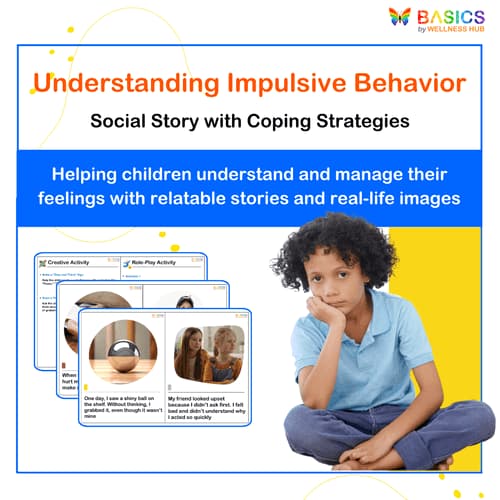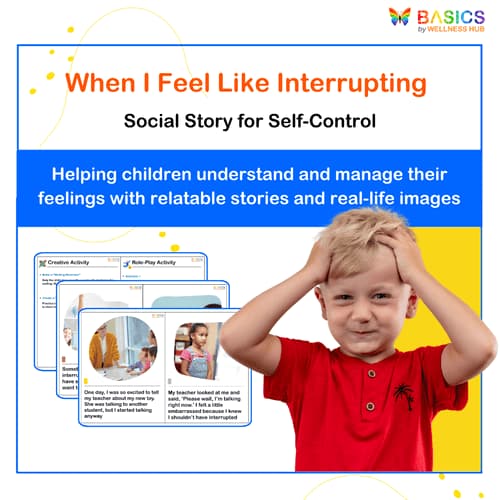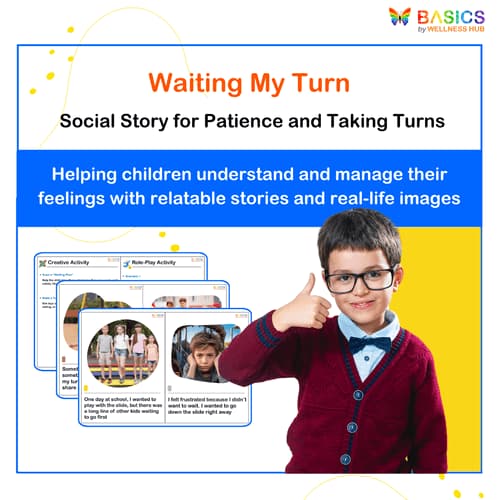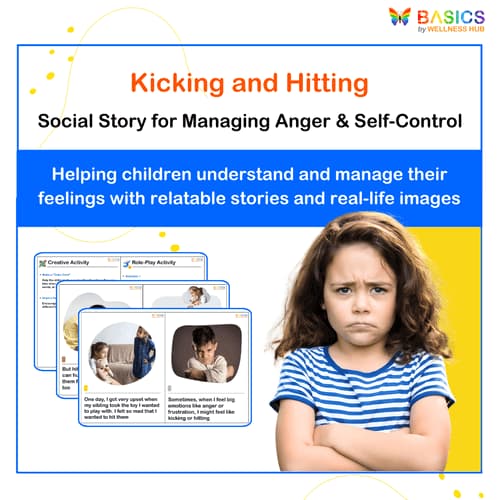





Overcoming Disappointment: A Social Story for Kids
₹80
₹160
50% off
0 (0 ratings)
Grade Levels
Pre-K - Elementary (Ages 4-8)
Content Overview
1 PDF, 6 pages, 12 statements with matching real-life images Features: First-person narrative, relatable real-life images, positive coping strategies
Pages from the Resource
This social story helps kids understand and manage feelings of disappointment. Using a first-person perspective and real-life images, it guides children through practical strategies for coping with disappointment in relatable everyday scenarios.

Page 1

Page 2
What Users Say
0
0 ratings
5
0+
4
0+
3
0+
2
0+
1
0+
5 Stars
Product is Good to use.
10 months ago
Varsha Parent
Similar Products

Understanding Impulsive Behavior: Social Story with Coping Strategies
₹ 80.00
₹ 160.00
50% off
4.9 (42 ratings)

When I Feel Like Interrupting – Social Story for Self-Control
₹ 80.00
₹ 160.00
50% off
4.8 (60 ratings)

Waiting My Turn – Social Story for Patience and Taking Turns
₹ 80.00
₹ 160.00
50% off
4.7 (56 ratings)

Kicking and Hitting – Social Story for Managing Anger & Self-Control
₹ 80.00
₹ 160.00
50% off
4.6 (52 ratings)

Understanding Swear Words – Social Story for Respectful Communication
₹ 80.00
₹ 160.00
50% off
4.9 (48 ratings)
About the Product
Purpose of Flashcards: The “Overcoming Disappointment” social story is a thoughtfully crafted resource designed to help young children understand and manage the difficult emotion of disappointment. Through a first-person narrative and relatable real-life images, this story provides practical strategies that kids can apply in everyday situations where they might feel let down. This resource is particularly beneficial for neurodiverse children, children with special needs, or any young child learning emotional regulation and coping skills.
Product Details
Format: Digital PDF
Total Number of Pages: 6
Features: First-person narrative format to promote relatability. High-quality real-life images that depict each scenario. 12 statements guiding children on how to cope with disappointment in common situations. Realistic and contextually relevant visuals that enhance engagement and understanding.
Educational Benefits
Emotional Regulation: The story supports children in identifying and managing feelings of disappointment, fostering emotional resilience.
Social Skills Development: Helps children learn to respond to situations where things don't go as expected in a socially acceptable way.
Critical Thinking: Encourages children to reflect on their feelings and consider positive actions when faced with challenging emotions.
Relatability: The first-person narrative combined with real-life images ensures that children can easily see themselves in the scenarios presented, making it more impactful.
Instructions for Use
Introduce the Story: Explain to the child that this story will teach them what to do when they feel disappointed. Discuss the concept of disappointment and why it’s a normal feeling everyone experiences.
Read Together: Go through the story slowly, allowing time for the child to process each scenario. Ask questions like, “How do you think the character feels in this situation?” or “What would you do if this happened to you?”
Discuss Coping Strategies: After reading, talk about the strategies the story suggests for managing disappointment. Emphasize the importance of deep breathing, positive self-talk, and asking for help if needed.
Reinforce Learning: Use the strategies mentioned in the story during real-life moments when the child experiences disappointment. You can remind them by saying, “Remember what we read in the story about what to do when you feel disappointed?”
Frequent Review: Revisit the story regularly to reinforce the coping techniques, especially after moments when the child has successfully managed their emotions.
Additional Activities: Encourage the child to draw pictures or role-play scenarios where they practice managing disappointment using the strategies from the story.
Activities Using the Resource
Storytime Reflection: After reading the story, engage the child in a discussion by asking reflective questions like, “Can you think of a time you felt disappointed?”, “What did you do to feel better?”, and “How did the character in the story handle disappointment?” This activity encourages children to connect their own experiences to the story, reinforcing the coping strategies discussed and helping them understand how to manage similar feelings.
Role-Playing Scenarios: Create simple role-playing exercises where the child can act out situations that might cause disappointment, such as losing a game or not getting what they want. Practice positive coping mechanisms like deep breathing, positive affirmations, or talking to a trusted adult. This activity provides a safe environment for children to rehearse healthy responses, helping them build resilience when dealing with disappointment.
Emotion Identification Chart: Create an “Emotion Identification Chart” where the child can place stickers or draw faces to show how they feel after different activities, including moments of disappointment. Encourage them to express their feelings verbally and use the chart to identify when they might need the coping strategies learned from the story. This activity promotes self-awareness and helps children recognize and manage their emotions effectively.
Art Activity – Draw Your Feelings: Encourage the child to draw pictures that represent what disappointment feels like and what happiness or calm feels like. This creative activity allows children to express their emotions visually, helping them understand and articulate their feelings. Use this moment to reinforce that all emotions are natural and manageable, promoting emotional resilience.
Daily Check-Ins: Incorporate a daily check-in routine where the child shares one experience that made them feel disappointed and discusses how they managed those feelings. Over time, this activity builds emotional resilience and reinforces the coping strategies learned from the story, encouraging consistent reflection and self-regulation.
FAQs
Q1: Who is this resource designed for?
A1: This social story is suitable for children aged 4-8, particularly those who may struggle with managing emotions like disappointment. It’s also beneficial for neurodiverse children and children with special needs.
Q2: How should I introduce this story to my child?
A2: Start by discussing what disappointment means and why it’s a normal feeling. Then, read the story together, making sure to engage in conversations about the scenarios presented.
Q3: Can I use this resource with a group of children?
A3: Yes, this story can be used in group settings like classrooms or therapy sessions. Group activities such as role-playing or discussing feelings can be incorporated after reading.
Q4: What should I do if my child doesn’t seem to relate to the scenarios?
A4: Modify the discussion by relating the scenarios to your child’s personal experiences. For example, if the story discusses a disappointment at school, ask your child to share something similar that happened to them.
Q5: How often should I revisit this story?
A5: It’s beneficial to revisit the story regularly, especially after moments when the child experiences disappointment. This reinforces the coping techniques in real-life contexts.
Usage Rights and Restrictions
Personal Use: This resource is intended for personal or educational use only.
Sharing: You may print or digitally share the resource within a single household or classroom setting. The resource is protected under copyright laws, and usage is limited to non-commercial purposes only.
Distribution: Redistribution, resale, or modification of the content is strictly prohibited.
Conclusion
The “Overcoming Disappointment” social story is a valuable tool for teaching children how to manage and navigate feelings of disappointment in a positive and constructive way. By using relatable scenarios, high-quality images, and practical coping strategies, this resource empowers children to understand that disappointment is a natural part of life and equips them with the tools to manage it effectively. With consistent use, this story can help children build emotional resilience and confidence in handling challenging emotions.



